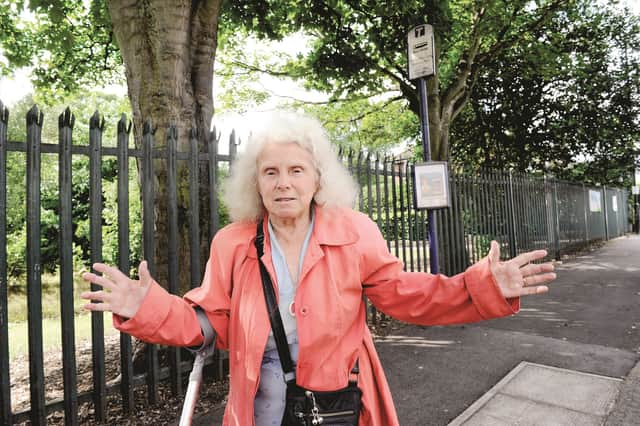Route change leaves disabled OAP with 30-MINUTE walk to bus stop


The calling points on Badsley Moor Lane were even raised within the last two years to make them easier for passengers like Shirley Dingwall (74, pictured).
But the timetable changes in spring put both stops out of use as the 111 and 112 were diverted — and Shirley said she and others have lost a valuable lifeline.
Advertisement
Hide AdAdvertisement
Hide AdShe added: “This is when public transport is no longer accessible to the public, when bosses on large wages in fancy cars take away buses in an area without leaving their offices or thoroughly investigating.
“These stops were used by lots of people, including those going to the Park rehabilitation centre for physio, people going to BreathingSpace and parents with children at the school around the corner.
“This thoughtlessness has isolated and deprived the vulnerable elderly and disabled people.
“We can’t do a marathon distance to a bus stop, so we’re deprived of getting to town or socialising. Some are going back to using cars.”
Advertisement
Hide AdAdvertisement
Hide AdThe bus stops were also used by patients at Park rehab and BreathingSpace, as well as parents with children at Badsley Primary School.
Shirley, of Browning Road, has suffered mobility problems from 18 months. She was lucky not to lose her right leg after an operation at Doncaster Gate Hospital when she was eight, doctors said.
Last year, she needed two operations on her right hip and earlier this year she fell and broke two bones in her back.
“I used these buses most days, sometimes twice a day,” Shirley said. “When I heard about what they were going to change, I complained at the bus station.
Advertisement
Hide AdAdvertisement
Hide Ad“Now I have to get on near the Park Hotel. It takes me nearly 30 minutes to get there. I’ve had to get people to help me across the road, like when it was really hot, otherwise I would have collapsed.
“After five months, I’m virtually giving up the struggle. One or two people have had to help me to get there.”
Shirley said she had seen one physio patient waiting over 20 minutes — believing the stops were still in use because they had not been clearly marked as inactive.
Keith Billington, chairman of Rotherham Pensioners Action Group, said: “Shirley informs me that there are around 20 neighbours in that area who have to walk now.
Advertisement
Hide AdAdvertisement
Hide Ad“The irony of it is that 18 months ago we got the council’s engineers to raise the kerb at the two stops on Badsley Moor Lane in order to get a more level entrance onto the bus.”
Mr Billington said he had asked SYPTE’s transport user group about the issue but to no avail.
An SYPTE spokeswoman said: “Bus companies sometimes revise routes to improve punctuality or reliability, or for commercial reasons. A new stop is proposed at Central Avenue, near the junction of Badsley Moor Lane.
“In the meantime, the nearest alternative bus stops for residents of Browning Road are at the junction of Badsley Moor Lane with Middle Lane South (service X10) or on Tennyson Road near to its junction with Browning Road (service 114).
Advertisement
Hide AdAdvertisement
Hide Ad“Rotherham Community Transport also offer services for customers with reduced mobility, or with fewer public transport options, in the area.”
Bronwen Knight, RMBC assistant director of transport, said raising the kerbs in October 2017 had cost £3,500.
“There is no process for recovering any costs,” she added. “In future, if the bus services use Badsley Moor Lane again, the infrastructure will already be in place.”
Shirley’s comments echo those of Herringthorpe resident Maureen Walker, who said elderly and disabled people have been left “isolated” by the rerouting of the 114 bus route.
Advertisement
Hide AdAdvertisement
Hide AdMrs Walker told the Advertiser in May that the service operated by First had been a social lifeline for many people as they used it to travel into Rotherham town centre.
She said changing the route to bypass a large section of Herringthorpe Valley Road had left its regular users, many of whom are in wheelchairs or have limited mobility, facing a long walk to catch the bus.
First blamed falling passenger numbers for the change.